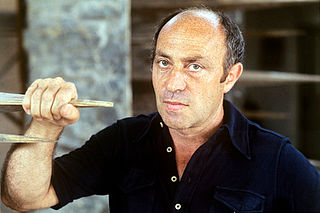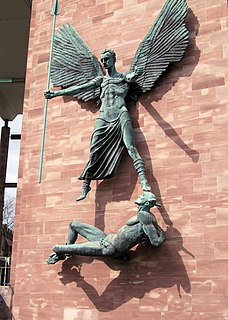
Bronze is the most popular metal for cast metal sculptures; a cast bronze sculpture is often called simply a "bronze". It can be used for statues, singly or in groups, reliefs, and small statuettes and figurines, as well as bronze elements to be fitted to other objects such as furniture. It is often gilded to give gilt-bronze or ormolu.

Lost-wax casting is the process by which a duplicate metal sculpture is cast from an original sculpture. Intricate works can be achieved by this method.

The Cimitero Monumentale[tʃimiˈtɛːro monumenˈtaːle] is one of the two largest cemeteries in Milan, Italy, the other one being the Cimitero Maggiore. It is noted for the abundance of artistic tombs and monuments.

The Chimera of Arezzo is regarded as the best example of ancient Etruscan artwork. British art historian, David Ekserdjian, described the sculpture as "one of the most arresting of all animal sculptures and the supreme masterpiece of Etruscan bronze-casting." Made entirely of bronze and measuring 78.5 cm high with a length of 129 cm, it was found alongside a small collection of other bronze statues in Arezzo, an ancient Etruscan and Roman city in Tuscany. The statue was originally part of a larger sculptural group representing a fight between a Chimera and the Greek hero Bellerophon. This sculpture was likely created as a votive offering to the Etruscan god Tinia.

Arnaldo Pomodoro is an Italian sculptor. He was born in Morciano, Romagna, Italy. He lives and works in Milan. His brother, Giò Pomodoro (1930–2002) was also a sculptor.

The Little Fourteen-Year-Old Dancer is a sculpture begun c. 1880 by Edgar Degas of a young student of the Paris Opera Ballet dance school, a Belgian named Marie van Goethem.

Alighiero Fabrizio Boetti known as Alighiero e Boetti was an Italian conceptual artist, considered to be a member of the art movement Arte Povera.
Roman Bronze Works, now operated as Roman Bronze Studios, is a bronze foundry in New York City. Established in 1897 by Riccardo Bertelli, it was the first American foundry to specialize in the lost-wax casting method, and was the country's pre-eminent art foundry during the American Renaissance.

Casting is a manufacturing process in which a liquid material is usually poured into a mold, which contains a hollow cavity of the desired shape, and then allowed to solidify. The solidified part is also known as a casting, which is ejected or broken out of the mold to complete the process. Casting materials are usually metals or various time setting materials that cure after mixing two or more components together; examples are epoxy, concrete, plaster and clay. Casting is most often used for making complex shapes that would be otherwise difficult or uneconomical to make by other methods. Heavy equipment like machine tool beds, ships' propellers, etc. can be cast easily in the required size, rather than fabricating by joining several small pieces.
The Pontificia Fonderia Marinelli is a bell foundry in Agnone, Italy. Founded no later than 1339, the foundry is one of the oldest family businesses in Italy.(subscription required) In addition to bells it produces bronze portals, bas-reliefs, church artifacts, and bell restorations.
Marisa Merz was an Italian artist and sculptor. In the 1960s, Merz was the only female protagonist associated with the radical Arte povera movement. In 2013 she was awarded the Golden Lion for Lifetime Achievement at the Venice Biennale. She lived and worked in Turin, Italy.

Morris Singer is a British art foundry, recognised as the oldest fine art foundry in the world. Its predecessor, Singer was established in 1848 in Frome, Somerset, by John Webb Singer, as the Frome Art Metal Works.

The Modern Art Foundry is an historic foundry in Astoria, Queens, New York, founded in 1932 by John Spring. His descendants continue to operate the business in what used to be the carriage house of the Steinway Mansion.
Norma Redpath was a prominent Australian sculptor.

The Arts of War and The Arts of Peace are bronze, fire-gilded statue groups on Lincoln Memorial Circle in West Potomac Park in Washington, D.C., in the United States. Commissioned in 1929 to complement the plaza constructed on the east side of the Lincoln Memorial as part of the Arlington Memorial Bridge approaches, their completion was delayed until 1939 for budgetary reasons. The models were placed into storage, and the statues not cast until 1950. They were erected in 1951, and repaired in 1974.

Giannino Castiglioni was an Italian sculptor and medallist. He worked mostly in monumental and funerary sculpture; his style was representational, and far from the modernist and avant-garde trends of the early twentieth century.
The Ferdinando Marinelli Artistic Foundry is one of the last remaining Florentine foundries, producing works in bronze utilizing the Renaissance technique of lost-wax. A large number of bronze sculptures produced in Florence over the last century come from this artistic foundry. One of the most famous and popular works in Florence, the 'La Fontana del Porcellino', was cast by the Marinelli Foundry in 1988 and replaced the antique in 1998.

The Arte Laguna Prize is an international art competition which takes place in Venice (Italy) and aimed at promoting and enhancing contemporary art. There are different contest sections: painting, sculpture and installation, photographic art, video art, performance, virtual art, digital graphics, land art, urban art and design. The competition is based in Venice, open to all, with free theme and no age restrictions. Its goal is to promote the artists and their careers through an array of opportunities.
Alessandro Nelli was an Italian entrepreneur. Nelli was the founder of the Fonderia Nelli, which was the leading sculpture foundry in Rome from 1880 to 1900. He participated to national, international and universal exhibitions, winning several prizes and medals. He exported more than 100 pieces to the 1893 World's Columbian Exposition in Chicago. Nelli made artistic bronzes for several Italian and foreign artists, including several American artists.
Jennie Lea Knight was an American sculptor.













